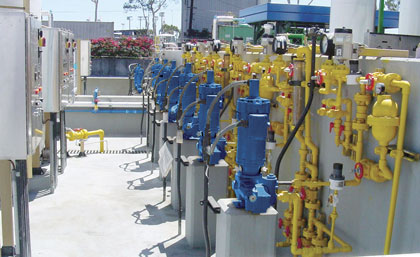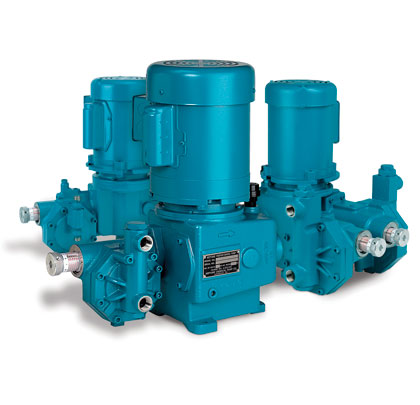Metering-pump technology can be easily set to deliver exact volumes according to a set schedule, and at varying pressures, and in last month’s introduction, we examined a number of variables to consider when selecting among the many different styles and modes of operation available. In this month’s conclusion, we move on to the components that will be needed for a successful installation.
PLANNING A METERING-PUMP INSTALLATION
So now that all of the variables have been identified and reviewed, it’s time to design the pumping system, keeping in mind any location or environmental concerns that may be present. For best results, the system’s design should originate from the liquid source or feed tank and work its way to the injection point while keeping in mind that metering pumps will be able to “push” against great pressures but will struggle to “pull” over longer distances.
This means that suction lift should be limited to no more than 4 feet and that a foot valve should be used in top-mount installations. Flooded suction is always preferred in a metering-pump installation as it makes the pump easier to prime, but the length of the flooded suction should be limited to 6 or 7 feet. And, as with all pump installations, adequately sized lines should be used and piping runs should have minimal bends, elbows, or other design characteristics that may restrict or limit flow.
Other components of the installation to consider include:
Suction Piping
The traditional rule of thumb is to use suction piping that is one size larger than the pump’s suction connection, though it is acceptable to use piping that is the same size as the suction connection if the metering pump will be operating at a slow speed when transferring low-viscosity chemicals. Generally, do not use hard piping that is smaller than 1/2-inch in diameter or that is smaller than 3/8-inch in diameter for low-flow applications that use plastic tubing.
Discharge Piping
The size of discharge piping is not as critical as that of suction piping, but the piping must be suitable for the discharge pressure. Typically, matching the pipe size to the discharge connection should be sufficient to ensure proper and reliable operation.
Suction Strainer
A suction strainer should always be used as it will prevent foreign matter from entering the pump’s ball checks.
Flanges/Unions/Compression Fittings
At least one of these must be installed at the pump’s suction and discharge ports in order to more easily facilitate maintenance procedures.

Isolation Valves
Large-port, quick-opening isolation valves should be placed at both the suction and discharge ends of the installation as a way to ease maintenance operations. Ball valves are usually the best choice for this operation, while needle valves should not be used because their design will cause the creation of a flow restriction.
Calibration Column
Because metering pumps very often feature pulsed flow at low volumes a draw-down calibration column is the most accurate and convenient method to measure pump performance, provided that the liquid in the column draws down smoothly and stops precisely at the end of each suction stroke. A tall, thin column should be used to ensure ease of reading and reporting accuracy. Calibration columns can also be helpful in determining if any wear has occurred or dirt has accumulated in the pump’s check valves; if the liquid in the column “bounces,” that may indicate that the valves are worn or dirty.
Relief Valve
Though the metering pump may be constructed with an internal relief valve, it is recommended that an external relief valve also be installed. The external relief valve should be set at 50 psi (3.5 bar) or 10% above the maximum operating pressure, whichever is greater. Any chemical that flows through the relief valve is piped back to the feed tank. Using transparent tubing for the relief valve will allow the operator to observe any returned fluid and identify any impurities. When piping the relief valve’s return to the suction side of the installation, the return must be upstream of the pump’s isolation valve so that the flow path will not become blocked.
Back-Pressure Valve
This component is only necessary when the installation does not produce adequate back pressure and the pump does not contain a built-in back-pressure device. Back-pressure valves are also required when a system has a low-pressure injection point that is hydraulically lower than the feed tank.
Pressure Gauge
If this optional device is installed, a diaphragm seal must be used if the pump is to be transferring chemicals that arte corrosive to stainless-steel gauge parts, or are viscous or contain particles that could clog the Bourdon tube within the gauge. The pressure gauge should be sized 30 to 50 percent larger than the maximum expected pressure that is produced by the system.
Pulsation Dampener
Pulsation dampeners are most commonly required in systems that feature long discharge lines where fluid acceleration during the pumping process can adversely affect the pump’s maximum pressure capacity or relief-valve setting. The pulsation dampener will minimize the pressure spikes that may be caused under these acceleration circumstances and, in the case of high-volume pumps, reduce piping harmonics.
Injection Quills/Check Valves
An injection quill that is installed at the pump’s injection pump will serve as a check valve while providing better dispersion of the chemical. In low-pressure applications, an injection quill that incorporates a corporation stop, which allows the injection quill to be inserted or removed without having to drain or shutdown the system, will improve efficiency and overall performance.
CONCLUSION
In process or agricultural applications where precise, reliable, efficient injection of chemicals is critical to optimizing performance, metering pumps have been proven over the years to deliver the required method of operation. However, knowing that requiring a metering pump is not nearly enough to ensure that the best pump will be chosen for the job. A long list of important variables must be considered, along with an array of pump components that will help optimize performance, if deployed appropriately. Successful chemical injection via metering pump will only be achieved if all variables are taken into consideration and system installation adheres to suggested protocols.
ABOUT THE AUTHOR
Tom O’Donnell is director of business development for Neptune™ Chemical Pump Company and PSG®. He can be reached at 215.699.8700, ext. 3327 or tom.odonnell@psgdover.com. Neptune is a leading manufacturer of chemical metering and peristaltic (hose) pumps, chemical feed systems, chemical injection accessories, make-down systems and industrial mixers, plus steam and water sample analysis panels. Neptune is a product brand of PSG®, a Dover company. For more information, visit www.neptune1.com and www.psgdover.com.
____________________________________________
MODERN PUMPING TODAY, June 2016
Did you enjoy this article?
Subscribe to the FREE Digital Edition of Modern Pumping Today Magazine!



